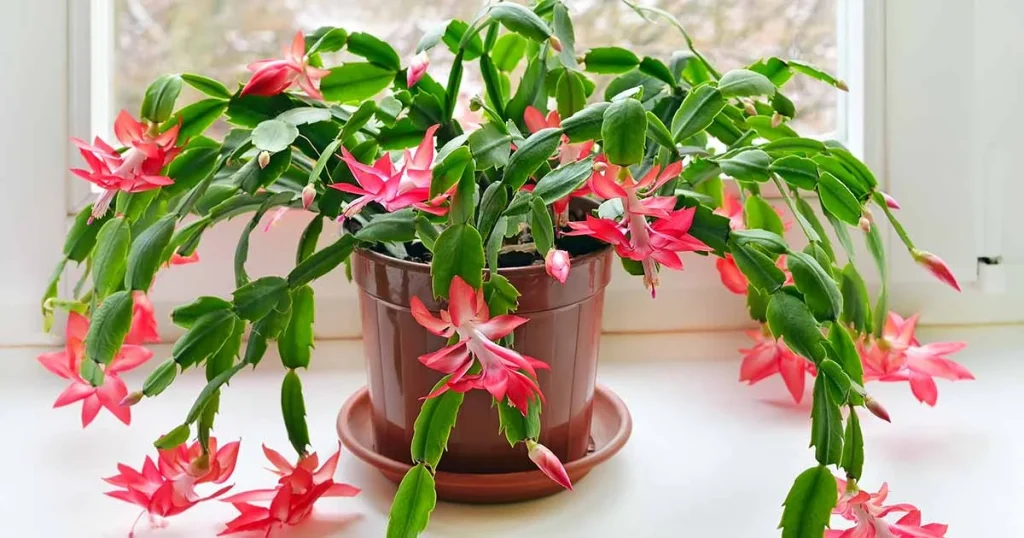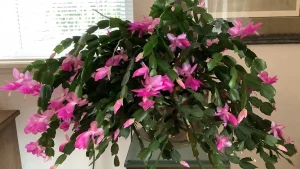The Christmas Cactus, a popular houseplant known for its vibrant blooms and festive appeal, is a favorite among plant enthusiasts. This article will cover everything you need to know about the Schlumbergera bridgesii, including its description, how to plant and care for it, common diseases and their solutions, whether the plant has a smell, and the different types of Christmas Cactus. Let’s dive into the world of this unique plant.
Description of Christmas Cactus
The Christmas Cactus (Schlumbergera bridgesii) is a unique cactus native to the coastal mountains of southeastern Brazil. Unlike typical desert cacti, the Schlumbergera bridgesii thrives in a humid environment and produces stunning pink, red, white, or yellow blooms around the holiday season. Its flattened, leaf-like segments create a cascading effect, making it an excellent choice for hanging baskets or decorative pots.
How to Plant Schlumbergera bridgesii
- Choosing the Right Pot and Soil:
- Opt for a well-draining potting mix tailored for cacti and succulents. Ensure that the pot features drainage holes to avoid waterlogging.
- Planting:
- Fill the pot with the potting mix, leaving room for the root ball.
- Gently place the Schlumbergera bridgesii in the pot, covering the roots with soil.
- Location:
- Place in a bright and indirect light location.
- Direct sunlight can scorch the leaves.
How to Care for Schlumbergera bridgesii
- Watering:
- Water the plant thoroughly when the top inch of soil is dry. After the blooming period, reduce watering to let the plant rest.
- Humidity and Temperature:
- Maintain a humidity level of around 50-60%.
- Keep the temperature between 60-70°F (15-21°C) for optimal growth.
- Fertilizing:
- Feed the Schlumbergera bridgesii with a balanced, water-soluble fertilizer every 3-4 weeks during the growing season (spring and summer).
- Pruning and Repotting:
- Prune the plant after the blooming period to encourage new growth.
- Repot every 2-4 years to refresh the soil and provide more room for growth.

Common Diseases and Solutions
- Root Rot:
- Caused by overwatering or poor drainage.
- Solution: Soil to dry out between waterings (ensure proper drainage).
- Leaf Drop:
- Can occur due to sudden changes in temperature or overwatering.
- Solution: Maintain consistent care and avoid drastic changes in the plant’s environment.
- Pests (Spider Mites, Mealybugs):
- Can damage the plant and hinder growth.
- Solution: Treat with insecticidal soap or neem oil and maintain proper plant hygiene.
Does Schlumbergera bridgesii Have a Smell?
The Schlumbergera bridgesii does not have a significant smell. Its primary appeal lies in its beautiful and vibrant flowers, which can brighten up any indoor space during the holiday season.
Synonyms of Schlumbergera bridgesii
The Christmas Cactus is known by various names and synonyms, reflecting its popularity and diverse cultural significance. Here are some common synonyms and related names for the Schlumbergera bridgesii:
- Schlumbergera bridgesii: The botanical name for the Christmas Cactus.
- Holiday Cactus: A general term encompassing Christmas, Thanksgiving, and Easter Cacti.
- Thanksgiving Cactus: Often confused with the Schlumbergera bridgesii, it blooms slightly earlier.
- Easter Cactus: Another close relative that blooms around Easter.
- Zygocactus: An older genus name that is sometimes used interchangeably with Schlumbergera.
- Winter Cactus: Refers to its blooming season during the winter holidays.
- Crab Cactus: Describes the claw-like shape of its segmented leaves.
- Flor de Maio: Portuguese for “May Flower,” reflecting its popularity in Brazil.
Schlumbergera bridgesii Colors
The Schlumbergera bridgesii is renowned for its vibrant and diverse range of bloom colors, making it a festive and eye-catching addition to any indoor garden. Here are the primary colors in which Christmas Cactus blooms are found:
- Pink: One of the most common and popular colors, offering a delicate and cheerful appearance.
- Red: A classic choice for the holiday season, adding a bold and festive touch.
- White: Elegant and pure, white blooms provide a serene contrast to the plant’s green foliage.
- Yellow: A less common but striking color, adding a unique and sunny element to the Schlumbergera bridgesii
- Orange: Vibrant and warm, orange blooms can add a tropical feel to your indoor garden.
- Purple: Rare but beautiful, purple flowers add a touch of luxury and depth to the plant’s appearance.
- Peach: Soft and charming, peach-colored blooms offer a gentle and pastel-like beauty.
Types of Christmas Cactus
There are several varieties of Christmas Cactus, each with unique features:
- Schlumbergera bridgesii:
- The most common variety, known for its pink or red blooms.
- Schlumbergera truncata (Thanksgiving Cactus):
- Often confused with Christmas Cactus, it blooms earlier and has pointed leaf segments.
- Schlumbergera x buckleyi (Easter Cactus):
- Blooms in spring with similar care requirements but different flowering times.
The Schlumbergera bridgesii is a wonderful addition to any home, offering beautiful blooms and a touch of festive cheer. By following the planting and care tips outlined above, you can enjoy a healthy and thriving Schlumbergera bridgesii year-round. Whether you’re a seasoned plant enthusiast or a beginner, this guide will help you grow and maintain this delightful plant.

